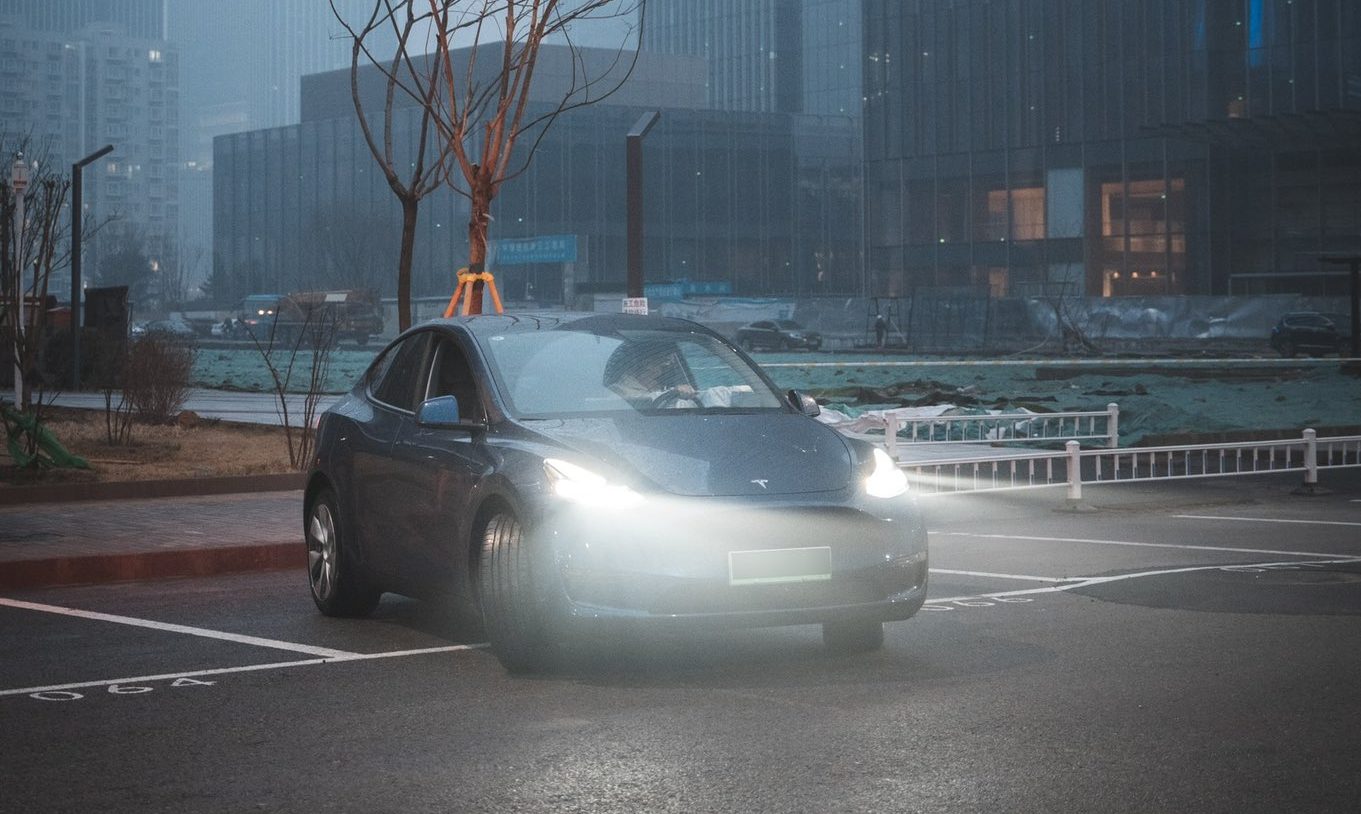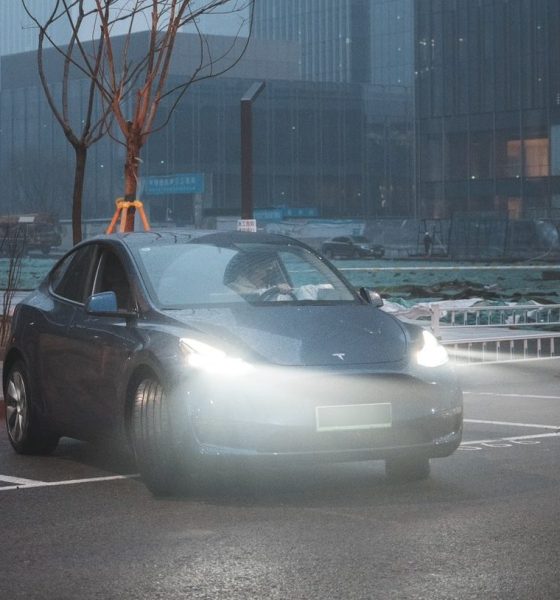

News
Tesla Model Y without radar gets the ultimate Forward Collision and Auto-Braking stress test
A Tesla Model Y equipped only with the automaker’s eight external cameras, and no radar underwent an extreme Forward Collision Warning (FCW) and Automatic Emergency Braking (AEB) stress test, thanks to owner Kevin Smith.
Smith, who has a new 2021 “Tesla Vision” Model Y without any radar hardware, wanted to assess the all-electric crossover’s ability to recognize and avert obstacles on a closed course. Smith said this was the second round of testing, and he used an inflatable clown as the obstacle that his vehicle would have to avoid to consider the test a successful one.
In May, Tesla announced that it would be removing radar from Model 3 and Model Y vehicles that were manufactured in May 2021 and beyond. In an attempt to transition to a camera-based approach for its cars, a plan that Tesla set out many months ago, the automaker chose its two mass-market vehicles as the guinea pigs to accumulate data for future use. The Model S and Model X are keeping radar, but only for a short time. Eventually, both Tesla flagship vehicles will also transition to Tesla Vision.
For now, the Model Y and Model 3 are the only two vehicles that will not utilize any radar hardware for the foreseeable future. Many owners who have utilized Tesla’s Autopilot of Full Self-Driving suites for semi-autonomous driving capabilities grew concerned when the automaker announced it would be ridding vehicles of any radar, with the most common complaint being performance in severe or low-visibility weather. Instead, Tesla believes that a vision-based approach will actually make the vehicle’s performance much more robust and accurate, comparing the vision-driven system to that of a human driver.
CEO Elon Musk commented on it during the Q1 2021 Earnings Call:
“…when your vision works, it works better than the best human because it’s like having eight cameras, it’s like having eyes in the back of your head, beside your head and has three eyes of different focal distances looking forward. This is — and processing it at a speed that is superhuman. There’s no question in my mind that with a pure vision solution, we can make a car that is dramatically safer than the average person.”
In Smith’s stress test, it proves that Tesla’s camera-based approach definitely needed some work early on. As a result, Tesla launched Software Update 2021.4.18.1, improving the performance of Autopilot for Vision-based automobiles. The vehicle successfully stopped while operating on Autopilot based on multiple test runs with the inflatable barrier. However, the manual test, where Smith controlled the car and depended on FCW and AEB to stop the car automatically, wasn’t as successful. All manual runs activated FCW, but AEB only interfered a handful of times. The vehicle didn’t stop, either. It only slowed down, softening the blow and unfortunately deflating Smith’s blow-up clowns.
Other owners have indicated that Autopilot’s performance with Tesla Vision has led to more confident showings of Autopilot compared to other vehicles that equip both cameras and radar. Tesla also added several safety features and new additions to vision-only vehicles. Teslas will only become more confident as the Neural Net compiles more data from Tesla Vision cars as they become more popular in the coming months.
Check out Kevin Smith’s video below, and let us know what you think in the comments!

Elon Musk
Elon Musk confirms xAI’s purchase of five 380 MW natural gas turbines
The deal, which was confirmed by Musk on X, highlights xAI’s effort to aggressively scale its operations.

xAI, Elon Musk’s artificial intelligence startup, has purchased five additional 380 MW natural gas turbines from South Korea’s Doosan Enerbility to power its growing supercomputer clusters.
The deal, which was confirmed by Musk on X, highlights xAI’s effort to aggressively scale its operations.
xAI’s turbine deal details
News of xAI’s new turbines was shared on social media platform X, with user @SemiAnalysis_ stating that the turbines were produced by South Korea’s Doosan Enerbility. As noted in an Asian Business Daily report, Doosan Enerbility announced last October that it signed a contract to supply two 380 MW gas turbines for a major U.S. tech company. Doosan later noted in December that it secured an order for three more 380 MW gas turbines.
As per the X user, the gas turbines would power an additional 600,000+ GB200 NVL72 equivalent size cluster. This should make xAI’s facilities among the largest in the world. In a reply, Elon Musk confirmed that xAI did purchase the turbines. “True,” Musk wrote in a post on X.
xAI’s ambitions
Recent reports have indicated that xAI closed an upsized $20 billion Series E funding round, exceeding the initial $15 billion target to fuel rapid infrastructure scaling and AI product development. The funding, as per the AI startup, “will accelerate our world-leading infrastructure buildout, enable the rapid development and deployment of transformative AI products.”
The company also teased the rollout of its upcoming frontier AI model. “Looking ahead, Grok 5 is currently in training, and we are focused on launching innovative new consumer and enterprise products that harness the power of Grok, Colossus, and 𝕏 to transform how we live, work, and play,” xAI wrote in a post on its website.
Elon Musk
Elon Musk’s xAI closes upsized $20B Series E funding round
xAI announced the investment round in a post on its official website.

xAI has closed an upsized $20 billion Series E funding round, exceeding the initial $15 billion target to fuel rapid infrastructure scaling and AI product development.
xAI announced the investment round in a post on its official website.
A $20 billion Series E round
As noted by the artificial intelligence startup in its post, the Series E funding round attracted a diverse group of investors, including Valor Equity Partners, Stepstone Group, Fidelity Management & Research Company, Qatar Investment Authority, MGX, and Baron Capital Group, among others.
Strategic partners NVIDIA and Cisco Investments also continued support for building the world’s largest GPU clusters.
As xAI stated, “This financing will accelerate our world-leading infrastructure buildout, enable the rapid development and deployment of transformative AI products reaching billions of users, and fuel groundbreaking research advancing xAI’s core mission: Understanding the Universe.”
xAI’s core mission
Th Series E funding builds on xAI’s previous rounds, powering Grok advancements and massive compute expansions like the Memphis supercluster. The upsized demand reflects growing recognition of xAI’s potential in frontier AI.
xAI also highlighted several of its breakthroughs in 2025, from the buildout of Colossus I and II, which ended with over 1 million H100 GPU equivalents, and the rollout of the Grok 4 Series, Grok Voice, and Grok Imagine, among others. The company also confirmed that work is already underway to train the flagship large language model’s next iteration, Grok 5.
“Looking ahead, Grok 5 is currently in training, and we are focused on launching innovative new consumer and enterprise products that harness the power of Grok, Colossus, and 𝕏 to transform how we live, work, and play,” xAI wrote.
Investor's Corner
Tesla gets price target bump, citing growing lead in self-driving

Tesla (NASDAQ: TSLA) stock received a price target update from Pierre Ferragu of Wall Street firm New Street Research, citing the company’s growing lead in self-driving and autonomy.
On Tuesday, Ferragu bumped his price target from $520 to $600, stating that the consensus from the Consumer Electronics Show in Las Vegas was that Tesla’s lead in autonomy has been sustained, is growing, and sits at a multiple-year lead over its competitors.
CES 2026 validates Tesla’s FSD strategy, but there’s a big lag for rivals: analyst
“The signal from Vegas is loud and clear,” the analyst writes. “The industry isn’t catching up to Tesla; it is actively validating Tesla’s strategy…just with a 12-year lag.”
The note shows that the company’s prowess in vehicle autonomy is being solidified by lagging competitors that claim to have the best method. The only problem is that Tesla’s Vision-based approach, which it adopted back in 2022 with the Model 3 and Model Y initially, has been proven to be more effective than competitors’ approach, which utilizes other technology, such as LiDAR and sensors.
Currently, Tesla shares are sitting at around $433, as the company’s stock price closed at $432.96 on Tuesday afternoon.
Ferragu’s consensus on Tesla shares echoes that of other Wall Street analysts who are bullish on the company’s stock and position within the AI, autonomy, and robotics sector.
Dan Ives of Wedbush wrote in a note in mid-December that he anticipates Tesla having a massive 2026, and could reach a $3 trillion valuation this year, especially with the “AI chapter” taking hold of the narrative at the company.
Ives also said that the big step in the right direction for Tesla will be initiating production of the Cybercab, as well as expanding on the Robotaxi program through the next 12 months:
“…as full-scale volume production begins with the autonomous and robotics roadmap…The company has started to test the all-important Cybercab in Austin over the past few weeks, which is an incremental step towards launching in 2026 with important volume production of Cybercabs starting in April/May, which remains the golden goose in unlocking TSLA’s AI valuation.”
Tesla analyst breaks down delivery report: ‘A step in the right direction’
Tesla has transitioned from an automaker to a full-fledged AI company, and its Robotaxi and Cybercab programs, fueled by the Full Self-Driving suite, are leading the charge moving forward. In 2026, there are major goals the company has outlined. The first is removing Safety Drivers from vehicles in Austin, Texas, one of the areas where it operates a ride-hailing service within the U.S.
Ultimately, Tesla will aim to launch a Level 5 autonomy suite to the public in the coming years.








